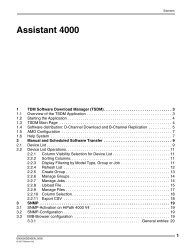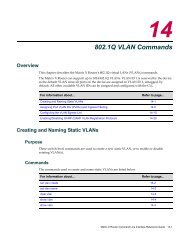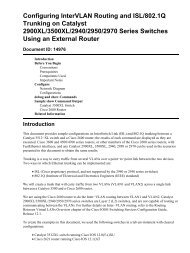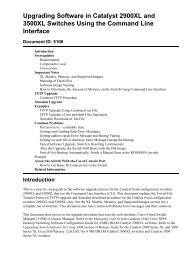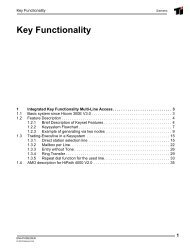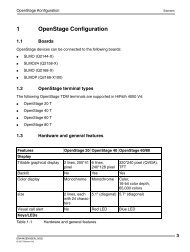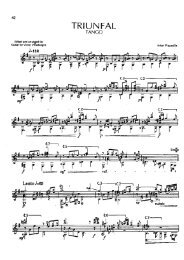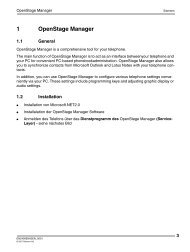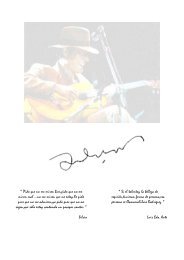1 Virtual Numbering (VNR) - Papagayo System, CA
1 Virtual Numbering (VNR) - Papagayo System, CA
1 Virtual Numbering (VNR) - Papagayo System, CA
- No tags were found...
You also want an ePaper? Increase the reach of your titles
YUMPU automatically turns print PDFs into web optimized ePapers that Google loves.
<strong>Virtual</strong> <strong>Numbering</strong> (<strong>VNR</strong>)SiemensShared use of a HiPath 4000 by different companiesInitial scenario:Bild 1-33 companies with independent communication systemsTarget scenario:Bild 1-4Three independent companies are assigned a virtual node in a shared HiPath4000 system. The virtual nodes here are not limited to APs or the HHS.EN4442EN00EN_0002© 2007 Siemens AG5
<strong>Virtual</strong> <strong>Numbering</strong> (<strong>VNR</strong>)Siemens1.2.2 Feature Principles1. When you activate this feature, a station number is only unique if combined with a nodecode. Station numbers for multiple assignment continue to be configured in the AMOWABE with the digit analysis result STN.2. Stations can be reached in a virtual node with their station number, even without a nodecode.3. Idle terminals display the station number without the node code.4. The display format for the station number in ringing or call status can be set individually foreach customer (international, national, local, unknown). This setting then applies to all stationsin the entire physical node.5. Overlapping station numbers (10, 100, 1000) must be configured on the basis of DPLNgroups.6. The node code and station number may not exceed 6 characters in length. This yields amaximum phone number length of 12 digits.1.2.3 Special Features and RestrictionsSpecial featuresThe following special features arise due to the use of <strong>VNR</strong>:●●●Features, such as, PU group, hunt group, CHESE, direct station selection, and COM group,can be configured for stations in different virtual nodes.The network-wide Team CHESE feature becomes redundant if the CHESE stations are locatedin a single system after the startup of a <strong>VNR</strong> node. In this case, use of the traditionalCHESE function can now be resumed.The node code is needed for unique identification in the Autoset Relocate and Mobile HFAfeatures.RestrictionsThe following restrictions must be observed:●●●Keysets with lines over different virtual nodes are not supported. (This restriction also appliesto TEAM / CHESE on a network-wide basis.)The members of the one number service must be located within a virtual node. Otherwisefalse information is displayed.Closed calling is no longer possible between stations with different E.164 station numbers.EN4442EN00EN_0002© 2007 Siemens AG7
Siemens<strong>Virtual</strong> <strong>Numbering</strong> (<strong>VNR</strong>)●A code hunt group cannot be assigned to a virtual node. It should always be consideredfor the entire physical node. A workaround is possible with floating stations.1.3 Generation1.3.1 Tasks Involved in Switching to <strong>VNR</strong>●●●●●To change a system without <strong>VNR</strong> to a system with <strong>VNR</strong> no virtual node number may beavailable in the system. That implies that it is not allowed a subsriber is configured. Thiscan be done by deleting all subscribers and correspondent settings or with a new generatingwith no subsribers (groups, virtual node numbers etc.).Each virtual node must be assigned a unique node code. This cannot be changed. All nodecodes must feature DAR=OWNNODE in the AMO WABE.The station terminals are generated with node codes in the relevant AMOs (SBCSU, SC-SU, etc.).After activating the <strong>VNR</strong> feature, SIP and HFA terminals must log on (LOGON) with nodecode and station number. The terminals should be provided with the new LOGIN data forthis purpose.Each virtual node must be assigned a unique E.164 station number.● LCR routes must be set up with reroute internal to ensure internal availability via the E.164station number. If all virtual nodes are located in one LAN, this can be implemented usingthree basic "reroute internal“ LCR routes (subscriber, national and international) for whichthe complete E.164 station number is mirrored. However, if a breakout to another locationis expected in the future, we advise changing over to a two-level LCR.●●●●●All station numbers assigned before feature activation in HiPath 4000 must be expandedto include the virtual node code for all features (for example, AMO ACTDA and AMO ZIEL).(Impact on the use of DLS, PCDACON, HiPath Manager, etc.)When using internal E.164 station number display (AMO ZANDE parameter DISPMOD),the format for internal display must be set in the AMO KNFOR (international, national, local).The format configured in the AMO KNFOR must then be set at least to the lowest commondenominator to be displayed. Station numbers are displayed between stations in differentvirtual nodes; display remains short within the local virtual node.If a shared trunk connection is used to reach multiple virtual nodes, an explicit E.164 stationnumber must always be sent by the CO. In this case, the VNNO parameter must notbe set in the AMO TDCSU.Connections between virtual nodes can only be restricted with ITR. Existing KNMAT restrictionsare to be changed over to ITR restrictions.The virtual node code is a component of the CHRGEE in call data recording.8EN4442EN00EN_0002© 2007 Siemens AG
<strong>Virtual</strong> <strong>Numbering</strong> (<strong>VNR</strong>)Siemens1.3.2 Network Integration●●An openly numbered network is basically a network with at least one <strong>VNR</strong> node (HiPath4000 V4 with the feature "<strong>Virtual</strong> <strong>Numbering</strong>" active).The following measures are necessary for closed numbering:– The area code in the <strong>VNR</strong> node must be truncated with the AMO KNMAT for closednumbering.– The usual KNMAT entries that are used for open numbering in the Hicom 300/HiPath4000 system connected to the <strong>VNR</strong> system are needed in all Hicom 300/HiPath 4000systems in the network.– In addition to the KNMAT modification in the systems, an OUTPULSE must be configuredin the AMO LODR with the node code for the <strong>VNR</strong> system.– Evaluations should be performed to check the effect of open numbering on existing applicationsand if any adjustments are necessary.– Adjustments may be necessary in call data recording.1.3.3 Description of AMO ApplicationThis section assumes general configuration skills, such as the ability to configure trunks, usersand features. Further information on this topic is provided in the service manual.>The configuration steps described in the following are based on Figure 1-2!As already mentioned, regeneration is necessary if you enable the use of non-unique stationnumbers in HiPath 4000. The <strong>VNR</strong> parameter is set to YES in the AMO ZANDE for definitionon a <strong>VNR</strong> system:CHANGE-ZANDE:TYPE=ALLDATA,<strong>VNR</strong>=YES;EN4442EN00EN_0002© 2007 Siemens AG9
Siemens<strong>Virtual</strong> <strong>Numbering</strong> (<strong>VNR</strong>)Before we come to the configuration of digit analysis and node definitions, a few explanationsare needed on the relationships between the AMOs WABE and KNDEF:Outgoing dialing is performed with the station's DPLN (AMO SBCSU).When DAR OWNNODE is reached, dialing with the DPLN of the destination node (AMOKNDEF) continues from this point.Here is an example as an aid to understanding:Let's consider STN (95)1007 from virtual node 1-1-5 and station (98)10 from virtual node1-1-8.<strong>Virtual</strong> node 1-1-5 uses four-digit numbering, such as 1007.<strong>Virtual</strong> node 1-1-8 uses two-digit numbering, such as 10.If STN (95)1007 wants to call STN (98)10, then the dial plan must be adjusted in the destinationnode after the node code is dialed.Station number "10" does not produce a result in the DPLN of the STN (95)1007.The outcome is identical if STN (98) 10 calls STN (95)1007.Station number "10" produces a result in the DPLN associated with STN (98)10, but dialingis incomplete in virtual node 1-1-5.For this reason, when DAR OWNNODE is reached, subsequent dialing is evaluated with theDPLN of the destination node.ADPLN indicates which DPLN may be assigned to a station in the virtual node with ADD/CHANGE-SBCSU/SSCSU/SCSU:...,DPLN=,...;.The DPLN is now configured according to the generation sequence. The following should benoted here:●●The DAR OWNNODE should always be configured independently of the DPLN.In contrast to earlier versions, the DAR STN can now be configured contingent on theDPLN. In the case of a <strong>VNR</strong> system, we recommend generating the DAR=STN contingenton the DPLN to avoid problems with future expansions.First of all, the physical node code that is entered in the AMO ZAND as PNODECD is configuredas DAR=OWNNODE.The physical node code must be unique throughout the network and should not correspond toany virtual node code because virtual nodes can be distributed over several physical nodes.As the subscriber does not select the physical node code, station numbers are frequently enteredwith * to avoid limiting the numbering scheme:ADD-WABE:CD=**95,DAR=OWNNODE,CHECK=N;10EN4442EN00EN_0002© 2007 Siemens AG
<strong>Virtual</strong> <strong>Numbering</strong> (<strong>VNR</strong>)SiemensDAR=OWNNODE should also be configured for all account codes in the virtual nodes:ADD-WABE:CD=95,DAR=OWNNODE,CHECK=N;ADD-WABE:CD=96,DAR=OWNNODE,CHECK=N;ADD-WABE:CD=97,DAR=OWNNODE,CHECK=N;ADD-WABE:CD=98,DAR=OWNNODE,CHECK=N;The station numbers are now configured on the basis of DPLN groups: As usual, a whole blockof numbers is prepared:ADD-WABE:CD=10&&29,DPLN=0,DAR=STN;ADD-WABE:CD=100&&299,DPLN=1,DAR=STN;ADD-WABE:CD=1000&&1999,DPLN=2,DAR=STN;Next, the physical node number and node code are entered in the AMO ZAND:CHANGE-ZAND:TYPE=ALLDATA,…,PNNO=10-1-5,PNODECD=**95;The virtual nodes are now configured with the AMO KNDEF. This involves assigning the uniqueISDN station number (E.164 station number) and the unique node code:ADD-KNDEF:NNO=1-1-5,TYPE=OWN, ISDNCC=49,ISDNAC=89,ISDN-LC=7221,ISDNSK=4, NODECD=95,NODECDSK=2,DPLN=2,ADPLN=2;ADD-KNDEF:NNO=1-1-6,TYPE=OWN, ISDNCC=49,ISDNAC=30,ISDN-LC=38645,ISDNSK=5, NODECD=96,NODECDSK=2,DPLN=1,ADPLN=1;ADD-KNDEF:NNO=1-1-7,TYPE=OWN, ISDNCC=49,ISDNAC=631,ISDN-LC=7974,ISDNSK=4, NODECD=97,NODECDSK=2,DPLN=1,ADPLN=1;ADD-KNDEF:NNO=1-1-8,TYPE=OWN, ISDNCC=49,ISDNAC=89,ISDN-LC=636123,ISDNSK=6, NODECD=98,NODECDSK=2,DPLN=0,ADPLN=0;The stations are now configured. Note that the node code is part of the station number withwhich the station is configured.Add the station for virtual node 1-1-5:ADD-SBCSU:STNO=951007,OPT=OPTI,CONN=DIR,PEN=1-1-3-0,DVCFIG=OPTIIP,COS1=2,COS2=1,LCOSV1=1,LCOSV2=1,LCOSD1=1,LCOSD2=1,,DPLN=2;ADD-SBCSU:STNO=951008,OPT=OPTIIP,CONN=DIR,PEN=1-1-3-0,DVCFIG=OPTIIP,COS1=1,COS2=1,LCOSV1=1,LCOSV2=1,LCOSD1=1,LCOSD2=1,DPLN=2;Add the station for virtual node 1-1-6:EN4442EN00EN_0002© 2007 Siemens AG11
Siemens<strong>Virtual</strong> <strong>Numbering</strong> (<strong>VNR</strong>)ADD-SBCSU:STNO=96100,OPT=OPTI,CONN=DIR,PEN=1-17-3-0,DVCFIG=OPTIIP,COS1=1,COS2=1,LCOSV1=1,LCOSV2=1,LCOSD1=1,LCOSD2=1,,DPLN=1;ADD-SBCSU:STNO=96200,OPT=OPTIIP,CONN=DIR,PEN=1-17-3-1,DVCFIG=OPTIIP,COS1=1,COS2=1,LCOSV1=1,LCOSV2=1,LCOSD1=1,LCOSD2=1,,DPLN=1;Add the station for virtual node 1-1-7:ADD-SBCSU:STNO=97100,OPT=OPTI,CONN=DIR,PEN=1-26-3-0,DVCFIG=OPTIIP,COS1=1,COS2=1,LCOSV1=1,LCOSV2=1,LCOSD1=1,LCOSD2=1,,DPLN=1;ADD-SBCSU:STNO=97200,OPT=OPTI,CONN=DIR,PEN=1-26-3-1,DVCFIG=OPTIIP,COS1=1,COS2=1,LCOSV1=1,LCOSV2=1,LCOSD1=1,LCOSD2=1,,DPLN=1;Add the station for virtual node 1-1-8:ADD-SBCSU:STNO=9810,OPT=OPTIIP,CONN=DIR,PEN=1-1-3-1,DVCFIG=OPTIIP,COS1=1,COS2=1,LCOSV1=1,LCOSV2=1,LCOSD1=1,LCOSD2=1,DPLN=0;ADD-SBCSU:STNO=9820,OPT=OPTIIP,CONN=DIR,PEN=1-1-3-2,DVCFIG=OPTIIP,COS1=1,COS2=1,LCOSV1=1,LCOSV2=1,LCOSD1=1,LCOSD2=,DPLN=0;Because the users of the virtual node are routed in different ways, source-dependent routing isrequired here.The stations of the different virtual nodes are assigned to different source groups for this purpose,unless this assignment is not already fixed by a unique position within their own APs.We will assign stations in node 1-1-5 to source group 1.CHANGE-SDAT:STNO=951000&&951999,TYPE=DATA1,SRCGRP=1;We will assign stations in node 1-1-8 to source group 2.CHANGE-SDAT:STNO=9810&&9829,TYPE=DATA1,SRCGRP=2;We will assign stations in node 1-1-6 to source group 17 based on the AP number.CHANGE-SDAT:STNO=96100&&96299,TYPE=DATA1,SRCGRP=17;Accordingly, we will assign stations in node 1-1-7 to source group 26.CHANGE-SDAT:STNO=97100&&97299,TYPE=DATA1,SRCGRP=26;Our example assumes that each virtual node also has its own central office access.12EN4442EN00EN_0002© 2007 Siemens AG
<strong>Virtual</strong> <strong>Numbering</strong> (<strong>VNR</strong>)Siemens1.3.4 Modified Display for E.164In HiPath 4000 V4, the following display format options are available for virtual station numbers:●●●Node code + station number (AMO ZANDE, parameter DISPMOD=UNKNOWN),PNP data + station number (AMO ZANDE, parameter DISPMOD=PRIVATE),E.164 data + station number (ZANDE, parameter DISPMODE=ISDN)Data in AMO KNDEF, AMO KNFOR and AMO KNPRE is accessed.This modified display only applies to incoming/outgoing station numbers.Station numbers saved for key functions or administered using AMOs are always stored in theformat node code + station number.1.3.5 Relevant AMOsThe following AMOs and parameters specified must be considered when activating the feature:AMO Parameter Sprache/Beschreibung/DescriptionLanguageACDGP SUPERRNR d Knotenkennzahl + TeilnehmerrufnummerSUPEXT e node number + extension numberACDRT TLNNU d Knotenkennzahl + TeilnehmerrufnummerSTNO e node number + extension numberACDSD RCGADR d Knotenkennzahl + Teilnehmerrufnummer<strong>CA</strong>FDN e node number + extension numberACTDA ZIELRNRd Knotenkennzahl + TeilnehmerrufnummerRNRDESTNOenode number + extension numberSTNOAGENT AUTORNR d Knotenkennzahl + TeilnehmerrufnummerAUTOEXT e node number + extension numberAUN TLNNU d Knotenkennzahl + TeilnehmerrufnummerSTNO e node number + extension numberBERUM TLNNU d Knotenkennzahl + TeilnehmerrufnummerSTNO e node number + extension numberEN4442EN00EN_0002© 2007 Siemens AG13
Siemens<strong>Virtual</strong> <strong>Numbering</strong> (<strong>VNR</strong>)AMO Parameter Sprache/LanguageCHESECHEFSEKVTREXECSECRREPALTCHEFNEUCHEFOLDEXECNEWEXE<strong>CA</strong>LTSEKNEUSEKdededBeschreibung/DescriptionKnotenkennzahl + Teilnehmerrufnummernode number + extension numberKnotenkennzahl + Teilnehmerrufnummernode number + extension numberKnotenkennzahl + TeilnehmerrufnummerOLDSECR enode number + extension numberNEWSECRCOMGR TLNNU d Knotenkennzahl + TeilnehmerrufnummerSTNO e node number + extension numberDCIC TLNNR d Knotenkennzahl + TeilnehmerrufnummerSTNO e node number + extension numberDIDCR REGEL d Knotenkennzahl + TeilnehmerrufnummerDIGITS e node number + extension numberDSSU TLNNU d Knotenkennzahl + TeilnehmerrufnummerSTNO e node number + extension numberHISTA TLNNU d Knotenkennzahl + TeilnehmerrufnummerSTNO e node number + extension numberHOTLN ZIEL d Knotenkennzahl + TeilnehmerrufnummerDEST e node number + extension numberKCSU TLNNU d Knotenkennzahl + TeilnehmerrufnummerSTNO e node number + extension numberTLNNUSEK d Knotenkennzahl + Teilnehmerrufnummer=> muss gleiche Knotenkennzahl wie TLNNUhaben, d.h. im gleichen Virtuellen Knoten seinSTNOSEC e node number + extension number=> must be the same node number as inSTNO, they must be in the same virtual node14EN4442EN00EN_0002© 2007 Siemens AG
<strong>Virtual</strong> <strong>Numbering</strong> (<strong>VNR</strong>)SiemensAMO Parameter Sprache/LanguageBeschreibung/DescriptionKNDEF DFLT d Default Knoten (nur bei TYP=EIGEN)DFLT e default node (only with TYPE=OWN)KNNR d Virtuellle Knotennummer.Führende Nullen können eingegeben werden,werden aber unterdrückt.Nachfolgende Nullen sind nur bei Knoten vomTYP=FREMD erlaubt.Knotennummer 0-0-0 bedeutet Rest der Welt.NND e virtual node numbernode number 0-0-0 means rest of worldISDNSK d ISDN Skip Digits. Anzahl der Stellen von ParameterISDNLC die übersprungen werden müssenum die Teilnehmernummer zu extrahieren,wenn die Teilnehmernummer und die Hauptanschlußnummersich überlappenISDNSK e ISDN skip digits. Number of digits of parameterISDNLC which are to skip to extract the extensionnumber when extension number and officecode overlapISDNCC d ISDN Landeskennzahl (country code). Standardwert:* (keine Landeskennzahl)ISDNCC e ISDN country code. Default value: * (no countrycode)ISDNAC d ISDN Ortskennzahl (area code). Standardwert:* (keine Ortskennzahl)ISDNAC e ISDN area code. Default value: * (no area code)ISDNLC d ISDN Hauptanschlussnummer. Standardwert:********** (keine Hauptanschlussnummer)ISDNLC e ISDN local destination code. Default value:********** (no local destination code)KNOTENKZ d Knotenkennzahl fuer RufnummernplanunknownNODECD e Node access code for numberingplanunknownEN4442EN00EN_0002© 2007 Siemens AG15
Siemens<strong>Virtual</strong> <strong>Numbering</strong> (<strong>VNR</strong>)AMO Parameter Sprache/LanguageLEMANWABE d WABE Gruppe, die zur Bewertung der Zielrufnummerverwendet werden sollDPLN e dialplan group,EWABE d In diesem Virtuellen Knoten erlaubte WABEGruppen für die darin eingerichteten Teilnehmer.Dieser Parameter wird nur für AMO Konsistenzchecksbenötigt.ADPLNeKNOTKZSK d Skip Digits fuer Knotenkennzahl (ParameterKNOTENKZ). Anzahl der Stellen von ParameterKNOTENKZ die übersprungen werdenmüssen um die Teilnehmernummer zu extrahieren,wenn die Teilnehmernummer und dieKnotenkennzahl sich überlappenNODECDSK e Skip digits for node access code (parameterNODECD). Number of digits of parameter NO-DECD which are to skip to extract the extensionnumber when extension number and nodeaccess code overlapTLNNUd Knotenkennzahl + TeilnehmerrufnummerDUWA2STNOenode number + extension numberDID2LIN TLNNU d Knotenkennzahl + TeilnehmerrufnummerSTNO e node number + extension numberNAVAR TLNNU d Knotenkennzahl + TeilnehmerrufnummerSTNO e node number + extension numberPERSI RUFNU d Knotenkennzahl + TeilnehmerrufnummerRUFUMBeschreibung/DescriptionSTNO e node number + extension numberDUWA1,DUWA2, d Knotenkennzahl + TeilnehmerrufnummerFAX2DEEZDID/DID2enode number + extension numberFAX2DTEZ16EN4442EN00EN_0002© 2007 Siemens AG
<strong>Virtual</strong> <strong>Numbering</strong> (<strong>VNR</strong>)SiemensAMO Parameter Sprache/LanguageBeschreibung/DescriptionSA RNR d Master-Sammelanschluss:Knotenkennzahl + TeilnehmerrufnummerCD e master hunting group:node number + extension numberSBCSU TLNNU d Knotenzahl + TeilnnehmernummerSTNO e node number + extension numberWABE d Muss eine der erlaubten WABE Gruppen desParameters EWABE im AMO KNDEF sein.DPLNeSCSU TLNNU d Siehe SBSCUSTNO e see SBCSUWABE d Siehe SBSCUDPLN e see SBCSUSDAT KNNR d virtuelle KnotennummerUmkonfigurieren eines Teilnehmers in einenanderen Virtuellen Knoten.NNO e virtual node numberSSCSU TLNNU d Siehe SBSCUSTNO e see SBCSUWABE d Siehe SBSCUDPLN e see SBCSUSXSU TLNNUd Knotenkennzahl + TeilnehmerrufnummerHAUPTNUTLNNUXSTNOMAINOSTNOXenode number + extension numberTACSU ENACHT d Knotenkennzahl + TeilnehmerrufnummerINIGHT e node number + extension numberTDCSU ENACHT d Knotenkennzahl + TeilnehmerrufnummerINIGHT e node number + extension numberEN4442EN00EN_0002© 2007 Siemens AG17
Siemens<strong>Virtual</strong> <strong>Numbering</strong> (<strong>VNR</strong>)AMO Parameter Sprache/LanguageTGERTLNNU,FAXRU,DEERUGERRUSTNOFAXNODTENO NUST-NNOdeBeschreibung/DescriptionKnotenkennzahl + Teilnehmerrufnummernode number + extension numberTSU RNR d Knotenkennzahl + TeilnehmerrufnummerSTNO e node number + extension numberUPLO2 TLNNU d Knotenkennzahl + TeilnehmerrufnummerSTNO e node number + extension numberVBZGR TLNNU d Knotenkennzahl + TeilnehmerrufnummerSTNO e node number + extension numberWABE KZP d KZP=TLN kann jetzt WABE Gruppen abhängigeingerichtet werdenKZP=EIGENKZ für die Knotenkennzahl desVirtuellen Knotens – ist WABE Gruppen unabhängigDAR e DAR=STNRNR d RufnummerCD e extension numberZLNR d ZielnummerWird benötigt wenn Teilnehmer eines virtuellenKnotens sich in verschiedenen physikalischenKnoten befinden.DESTNO e destination numberWABE d WABE-Gruppeermöglicht die Eingabe einer neuen Teilnehmer- WABE Gruppen ZuordnungDPLN e dial planZANDE <strong>VNR</strong> d Leistunsgmerkmal “Virtueller Rufnummernplan”18EN4442EN00EN_0002© 2007 Siemens AG
<strong>Virtual</strong> <strong>Numbering</strong> (<strong>VNR</strong>)SiemensAMO Parameter Sprache/LanguageBeschreibung/Description<strong>VNR</strong> e Feature “<strong>Virtual</strong> Node Number”DISPMOD d Mögliche Werte:UNBEK=Nicht-<strong>VNR</strong>: Bei deaktiviertem virtuellenRufnummernplan (Feature <strong>VNR</strong>) wird dieTeilnehmer Nummer im kuerzest moeglichenFormat angezeigt. <strong>VNR</strong>: Bei aktiviertem virtuellenRufnummernplan (Feature <strong>VNR</strong>) wird dieTeilnehmer Nummer im Format KNOTENKZ +Teilnehmernummer angezeigt, z.B. 100 or 20100PRIVAT=Die Anzeige erfolgt im Format PrivaterNummerierungs - Plan , z.B.. 9 44 777 100ISDN=Die Anzeige erfolgt im E.164-Rufnummern-Format,z.B. 0 089 722 100DISPMOD e Possible values:UNKNOWN=Non <strong>VNR</strong>: For deactivated vitualnumbering (feature <strong>VNR</strong>) the display of shortestpossible subscriber numbers is done <strong>VNR</strong>:For activated vitual numbering (feature <strong>VNR</strong>)the display is done in format NODECD + subscribernumber, e.g. 100 or 20 100PRIVATE=display of subscriber number in privatnumbering plan format, e.g. 9 44 777 100ISDN=display of subscriber number in E.164format, e.g. 0 089 722 100ZIEL QLRUFNU d Quellrufnummer AULSRCNO e station number of source FWDTYP=NA d Namenstaste DRTYPE=NAME e name key DSSTZLRUFNU d Ziel-Rufnummer für NamenstastenDESTNON e destination number for name keysBUZRUFNUDZLRUFNURUFNUZLRUFNUBZLRUFNUKZLRUFNUd Knotenkennzahl + TeilnehmerrufnummerEN4442EN00EN_0002© 2007 Siemens AG19
Siemens<strong>Virtual</strong> <strong>Numbering</strong> (<strong>VNR</strong>)AMO Parameter Sprache/LanguageZIELNDESTNOBZDESTNODEVMCDDESTNOFDESTNOMDESTNORTLNNURNRRURNRBKRNR1RNR2DZLRUFNUVTRSEKRNRCH1RNRCH1VRNRCH2RNRCH2VRNRCH3RNRCH3VRNRCH4RNRCH3VSTNOSTNORXFRSTNOMBSTNO1STNO2DESTNODSTNOREPSTNOEX1STNOEX1RSTNOEX2STNOEX2RSTNOEX3STNOEX3RSTNOEX4STNOEX4RedeBeschreibung/Descriptionnode number + extension numberKnotenkennzahl + Teilnehmerrufnummernode number + extension number20EN4442EN00EN_0002© 2007 Siemens AG



